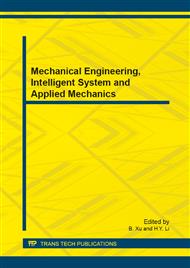p.25
p.30
p.35
p.39
p.46
p.50
p.57
p.61
p.65
Relative Attitude Determination of Formation Spacecraft Based on Flight Mechanics
Abstract:
According to " leader missiles - attack missiles " formation model, the measurement model of missile in formation flight VisNav is derived. The observability analysis of missile VisNav is shown for cases involving three vector observations, the conclusion is that at least three characteristic points are visible to insure visual navigation systems to work properly. The least square algorithm is applied to process the data of VisNav to estimate the relative attitude and position. The results of simulation show that the accuracy of least square algorithm would be influenced by the relative position of missile in formation flight mechanics.
Info:
Periodical:
Pages:
46-49
Citation:
Online since:
December 2013
Authors:
Price:
Сopyright:
© 2014 Trans Tech Publications Ltd. All Rights Reserved
Share:
Citation:


